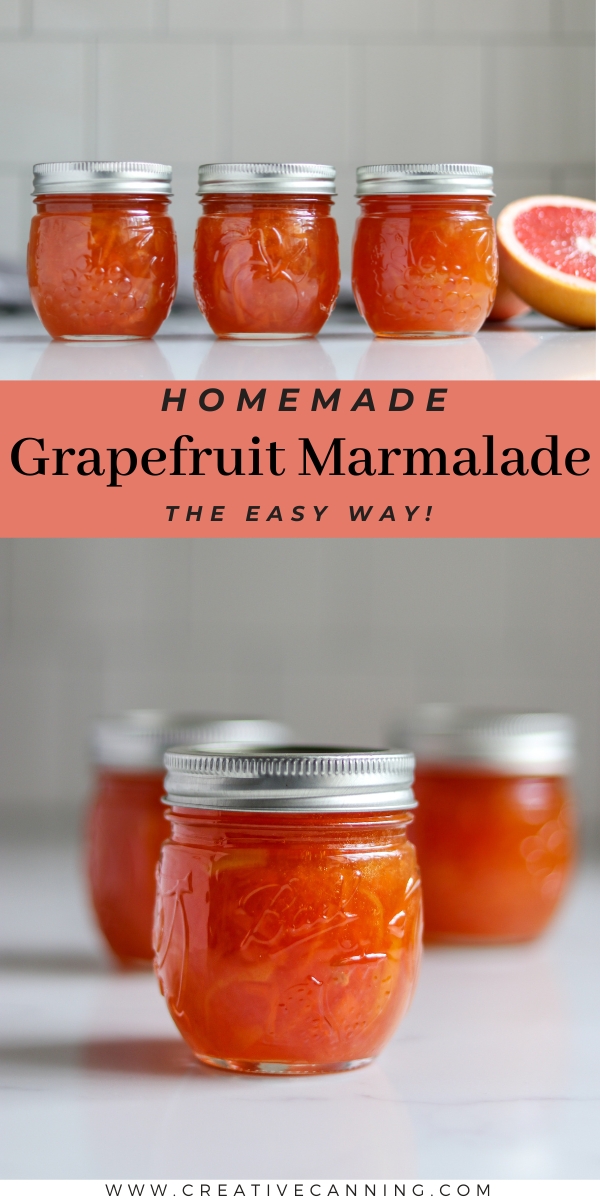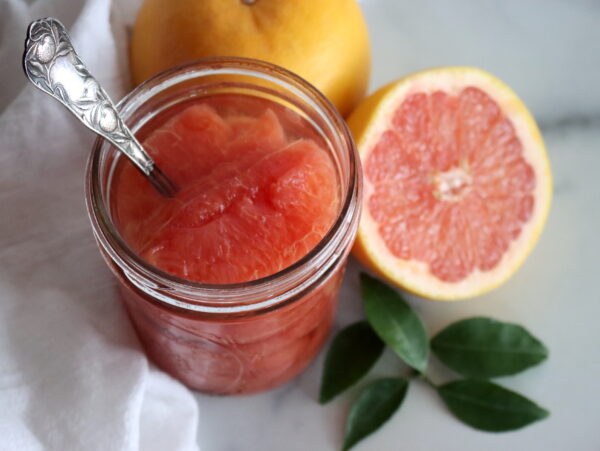This post may contain affiliate links. Please see our disclosure policy.
Grapefruit Marmalade is a delightful citrus marmalade recipe that really makes the most of fresh grapefruit in season.

Table of Contents
- Ingredients for Grapefruit Marmalade Jam
- How to Make Grapefruit Marmalade Jam
- Canning Grapefruit Marmalade
- Altitude Adjustments for Marmalade
- Grapefruit Marmalade Jam Variations
- Ways to Use Grapefruit Marmalade Jam
- Ways to Preserve Citrus
- Grapefruit Marmalade Recipe
- Altitude Adjustments for Marmalade
- Marmalade Recipes
- Citrus Canning Recipes
- Marmalade Recipes
It seems like orange marmalade always gets all the attention, but it’s not the only citrus fruit in the crate!
Lime lovers can make a truly excellent lime marmalade, but you’ve really got to love lime to enjoy it.
Grapefruit, on the other hand, has a much broader appeal, and grapefruit marmalade is loved but just about everyone!
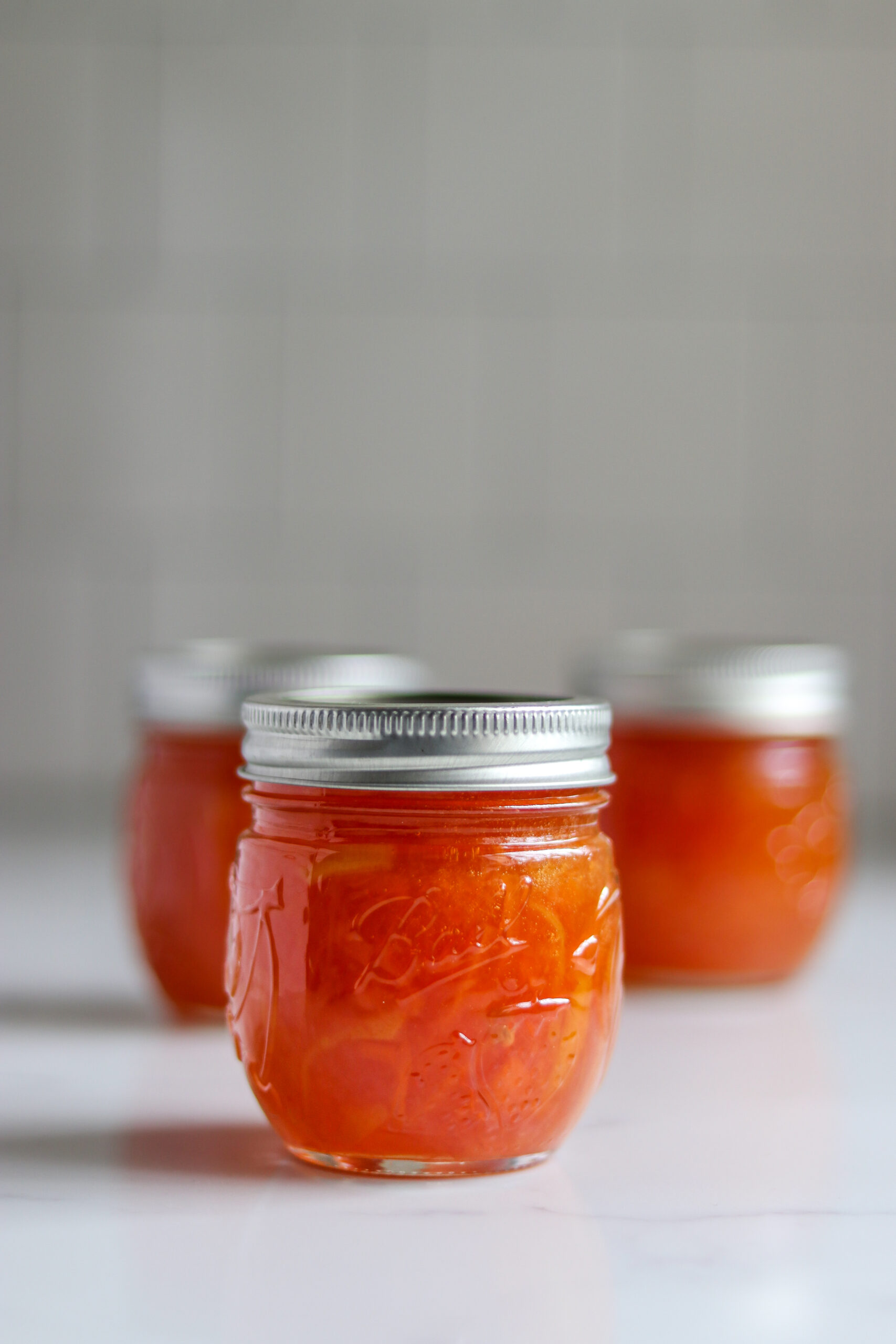
Ingredients for Grapefruit Marmalade Jam
Red grapefruit is generally not as tart as the yellow variety, and it makes a beautiful pink marmalade with just enough tang to accompany the sweetness.
Making marmalade uses both the flesh of the grapefruit and the outside rind, so I’d suggest choosing organic grapefruits.
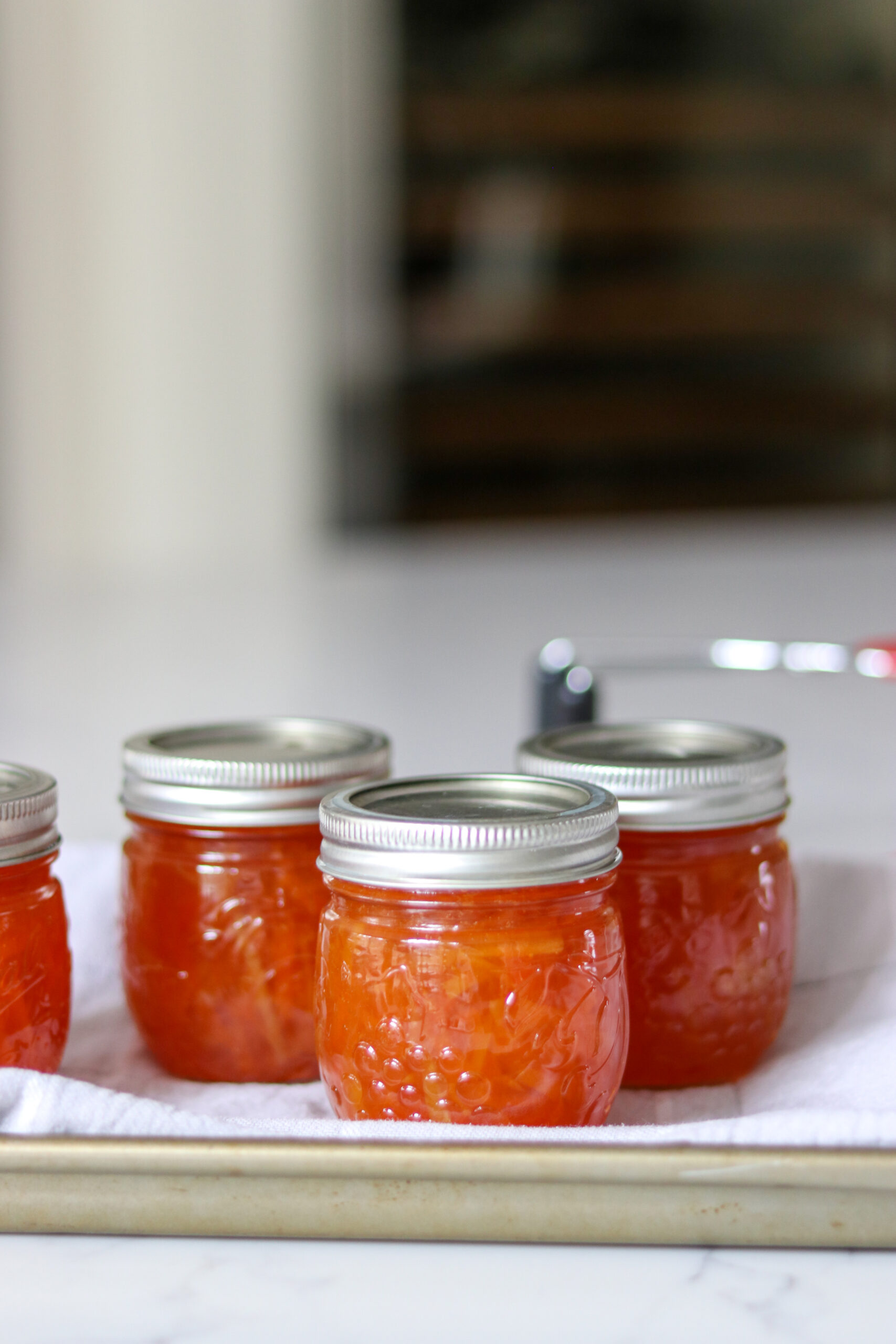
This particular grapefruit marmalade recipe is a quick marmalade, made with the addition of pectin. You can make it without pectin, but it takes much longer (sometimes days) to fully extract the pectin from the fruit and peels.
Ball Canning developed this much quicker recipe, and it’s adapted from the The All New Ball Book of Canning and Preserving.
To make 4 half-pint (8 oz.) jars of grapefruit marmalade, you will need the following:
- 3 large red grapefruits (about 2¾ pounds)
- 1 medium lemon
- 4 cups granulated sugar
- 2½ cups water
- 1/8 tsp. baking soda
- 1 package (1.75 oz.) regular Sure-Jell Premium Fruit Pectin (yellow box)
This recipe will also work with yellow grapefruit but will not be as sweet. Ensure you buy large red grapefruits to make this delicious grapefruit marmalade.
The original recipe calls for 6 tablespoons of Ball Classic Pectin, equivalent to the 1.75 oz. package of Sure-Jell this version calls for. You can use either, and boxed sure jel or 6 Tbsp or Ball Classic Pectin will both work the same way.
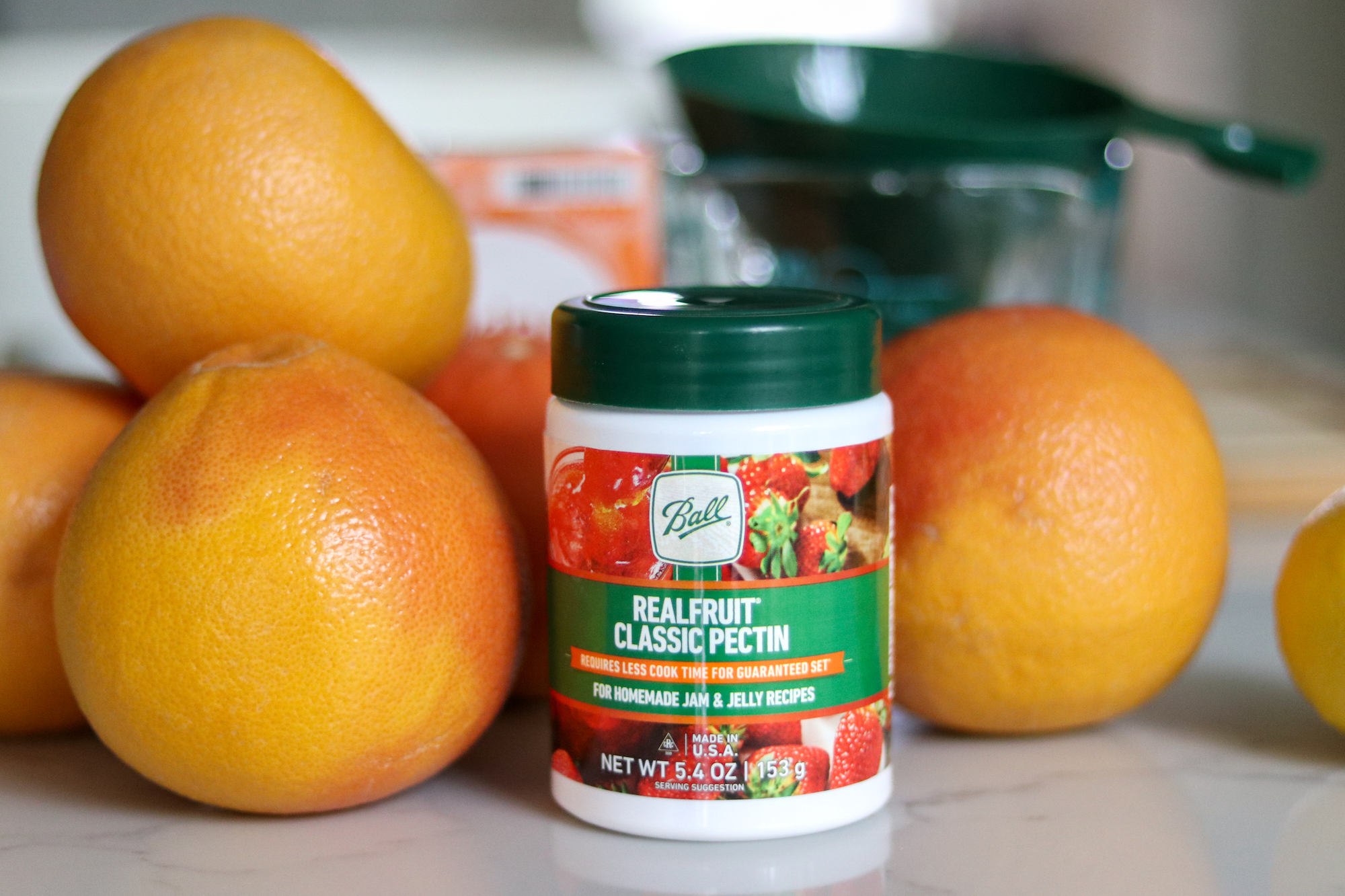
If you prefer to use less sugar, you can use a low-sugar pectin alternative (see Notes). This is an excellent option for those hoping to eat less sugar, and you cannot make a low sugar marmalade without pectin. Given that this recipe uses pectin anyway, substituting a low sugar pectin is an easy switch.
Using Sure-Jell Less or No Sugar Pectin (pink box) for example, you can make marmalade using only 2 cups of sugar instead of 4.
Note that using less sugar can reduce your yield, but you should get close to 4 half-pint jars of jelly with this recipe using less sugar.
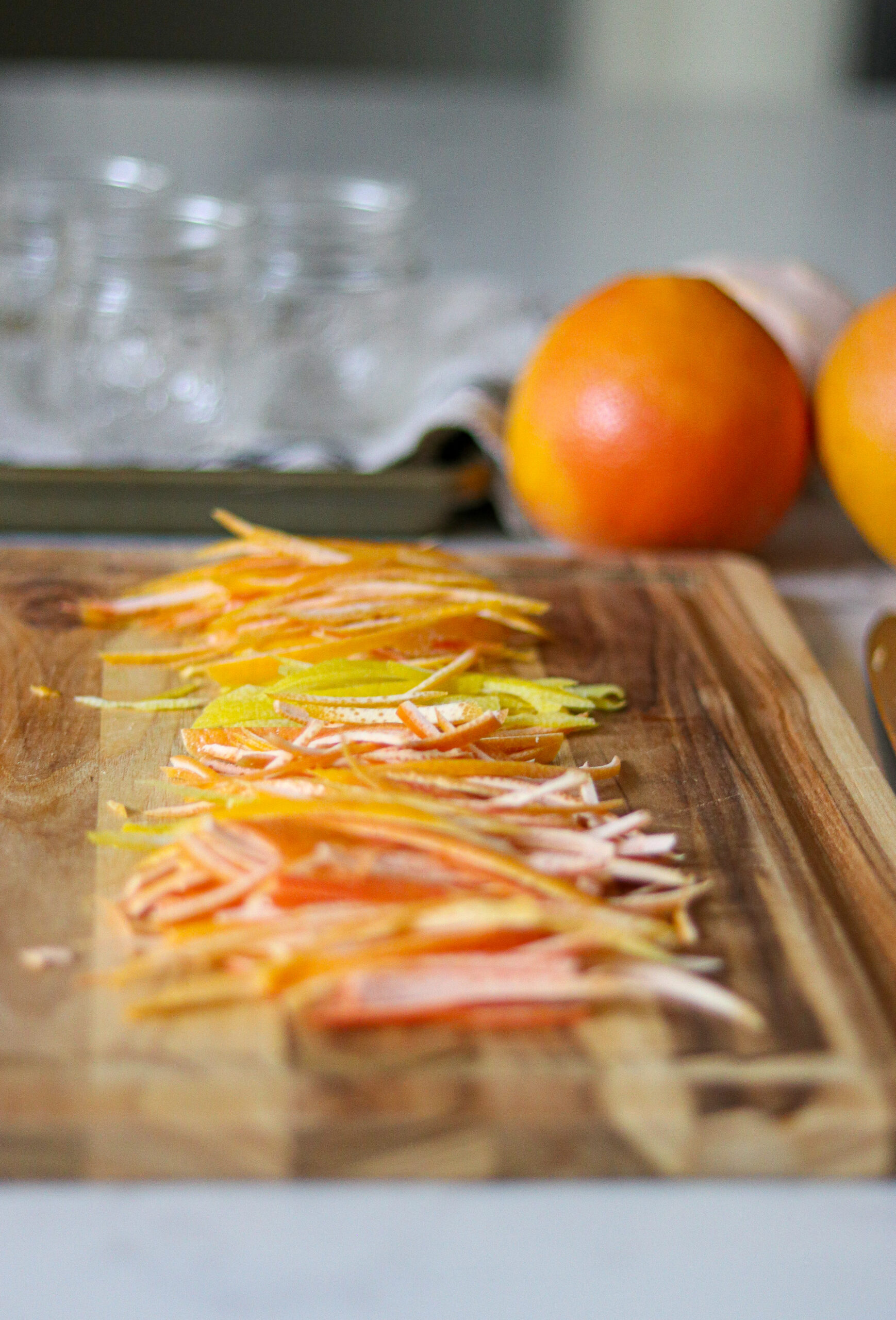
How to Make Grapefruit Marmalade Jam
If you are a beginner or are unsure of hot water bath canning, refer to my Beginner’s Guide to Water Bath Canning before proceeding.
Clean the grapefruits and lemon using a vegetable brush under clean water.
The USDA recommends not using a soap, detergent, or commercial produce wash.
If you are concerned about pesticides or chemicals on the fruit, you may wash your grapefruit and lemon with 2 tablespoons of baking soda mixed with 1 cup of water. Use that solution to thoroughly rub the skins of your fruit, and then rinse them with clean water. The alkaline properties of baking soda neutralize most common pesticides and other chemicals found on fruit.
Using a vegetable peeler, carefully peel just the outer layer of the grapefruits, trying to avoid getting too much of the bitter white part of the rind in with your peelings. Some grapefruits do not have a very thick rind, so take your time to peel only the outside layer of the grapefruit.
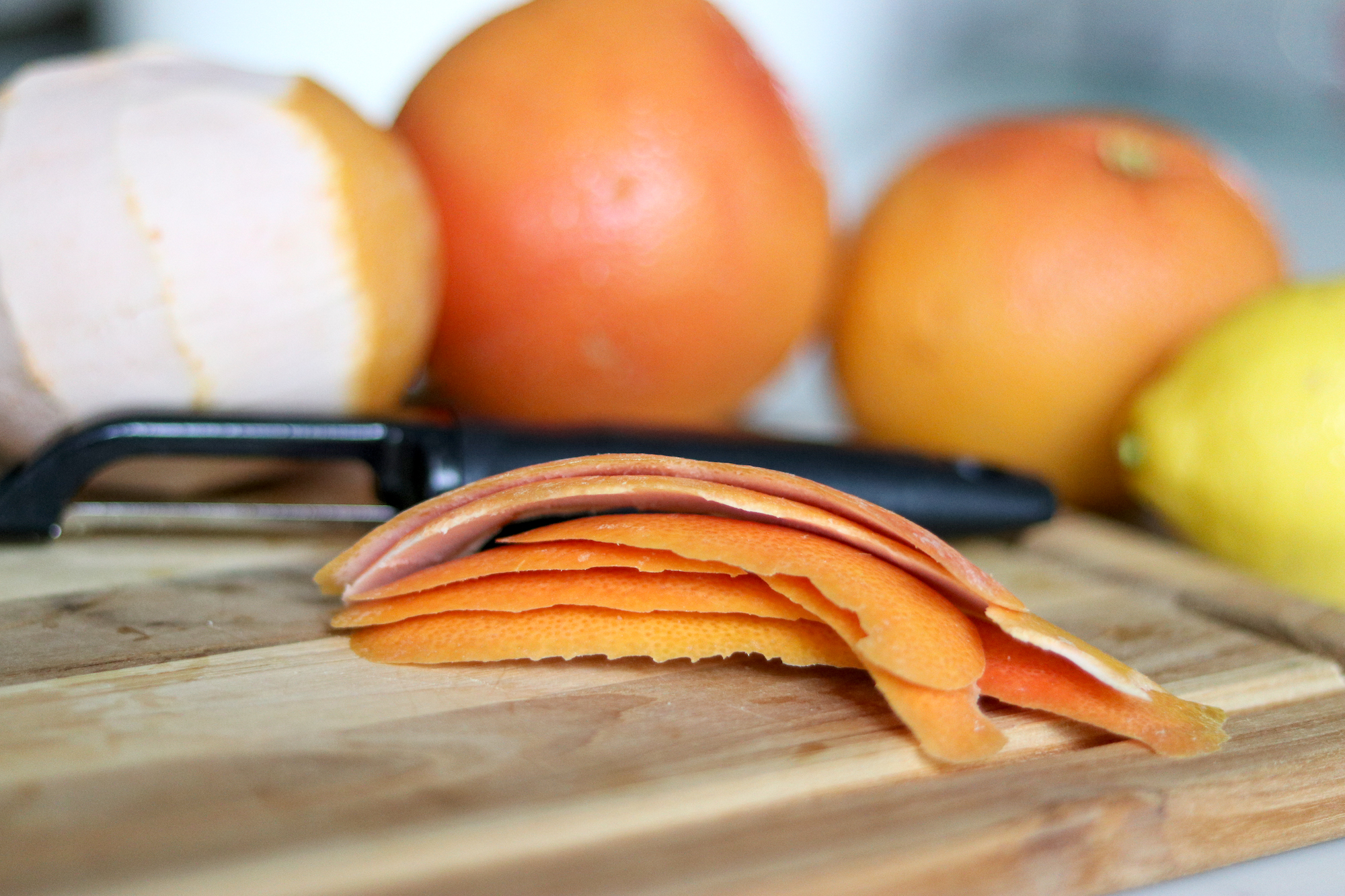
Do the same with the lemon, peeling only the outer yellow layer.
Chop the lemon and grapefruit rinds together into coarse pieces. You should have about 1 cup of chopped peelings.
Personally, I like long thin strips of peel, as I feel it gives a nice uniform look to the finished marmalade.
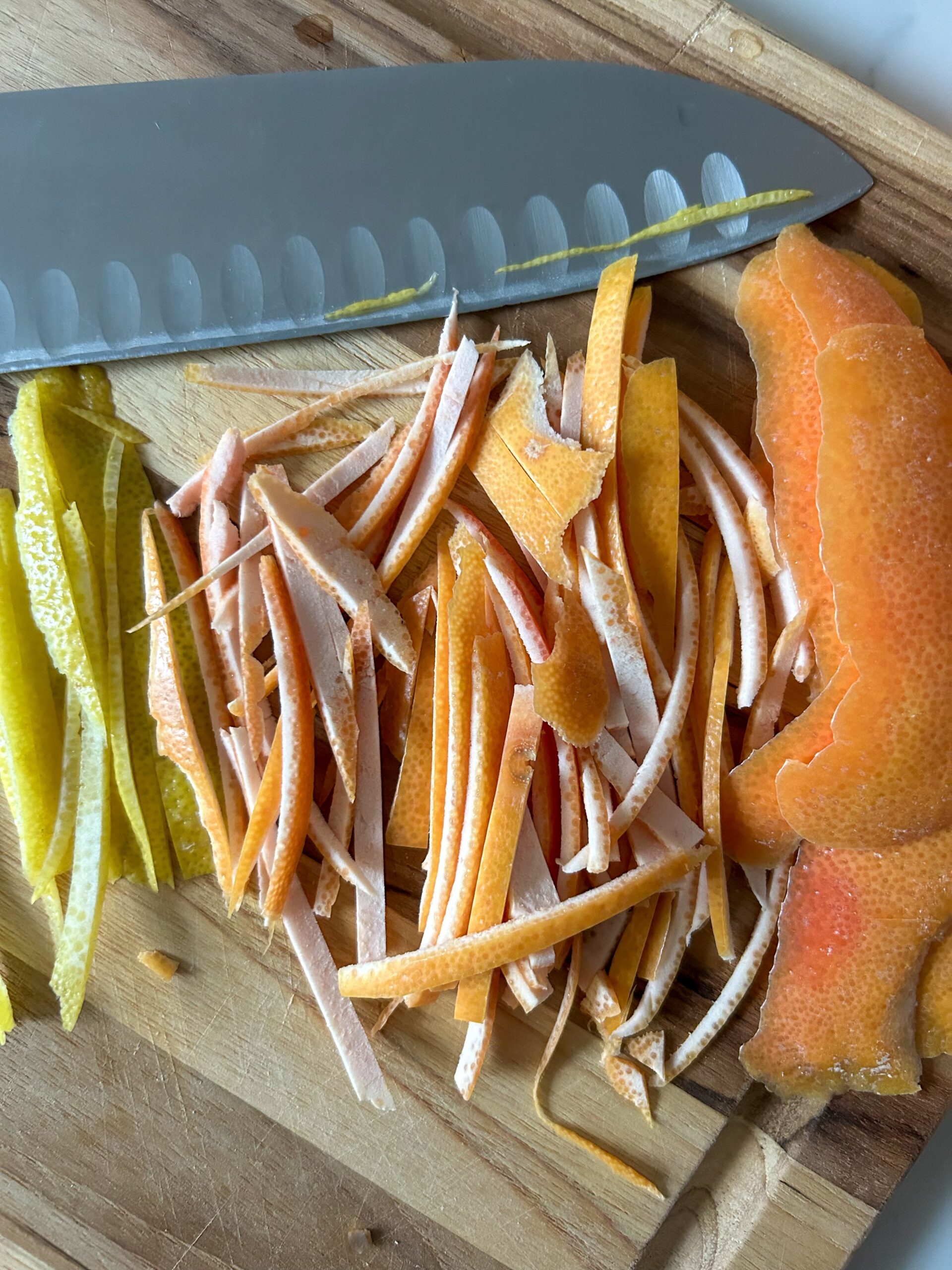
Place the chopped peelings into a large saucepan or jam pot.
Add 1/8 teaspoon of baking soda and 2½ cups of water to the peelings and stir to mix.
Adding the baking soda is important because it helps soften the peelings so you do not have tough rind pieces in your finished marmalade.
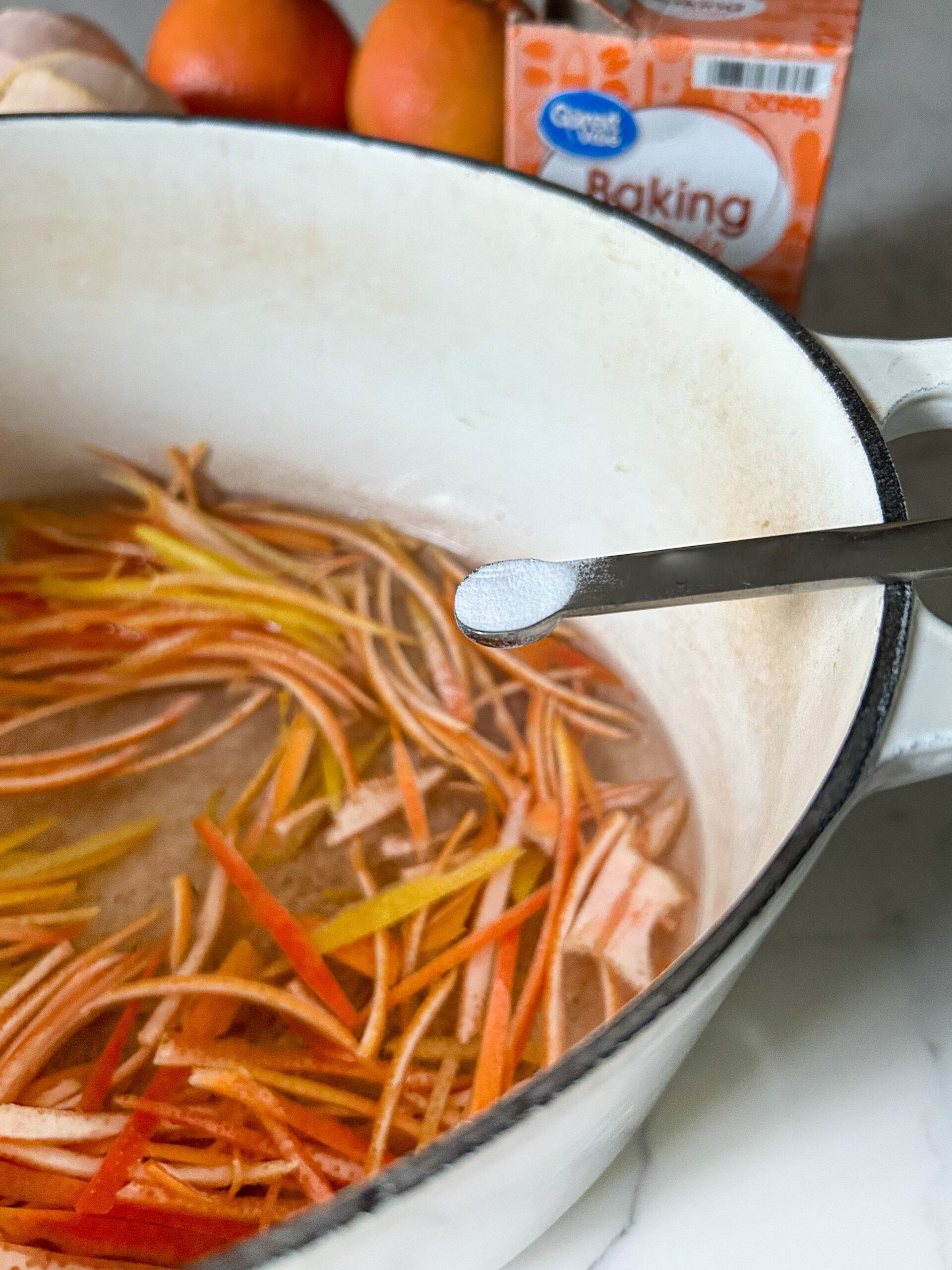
Over medium-high heat, bring this mixture of rinds, baking soda, and water to a boil, stirring occasionally.
Reduce the heat to medium-low and cover the saucepan or jam pot.
Let the mixture simmer for 20 minutes, continuing to stir occasionally.
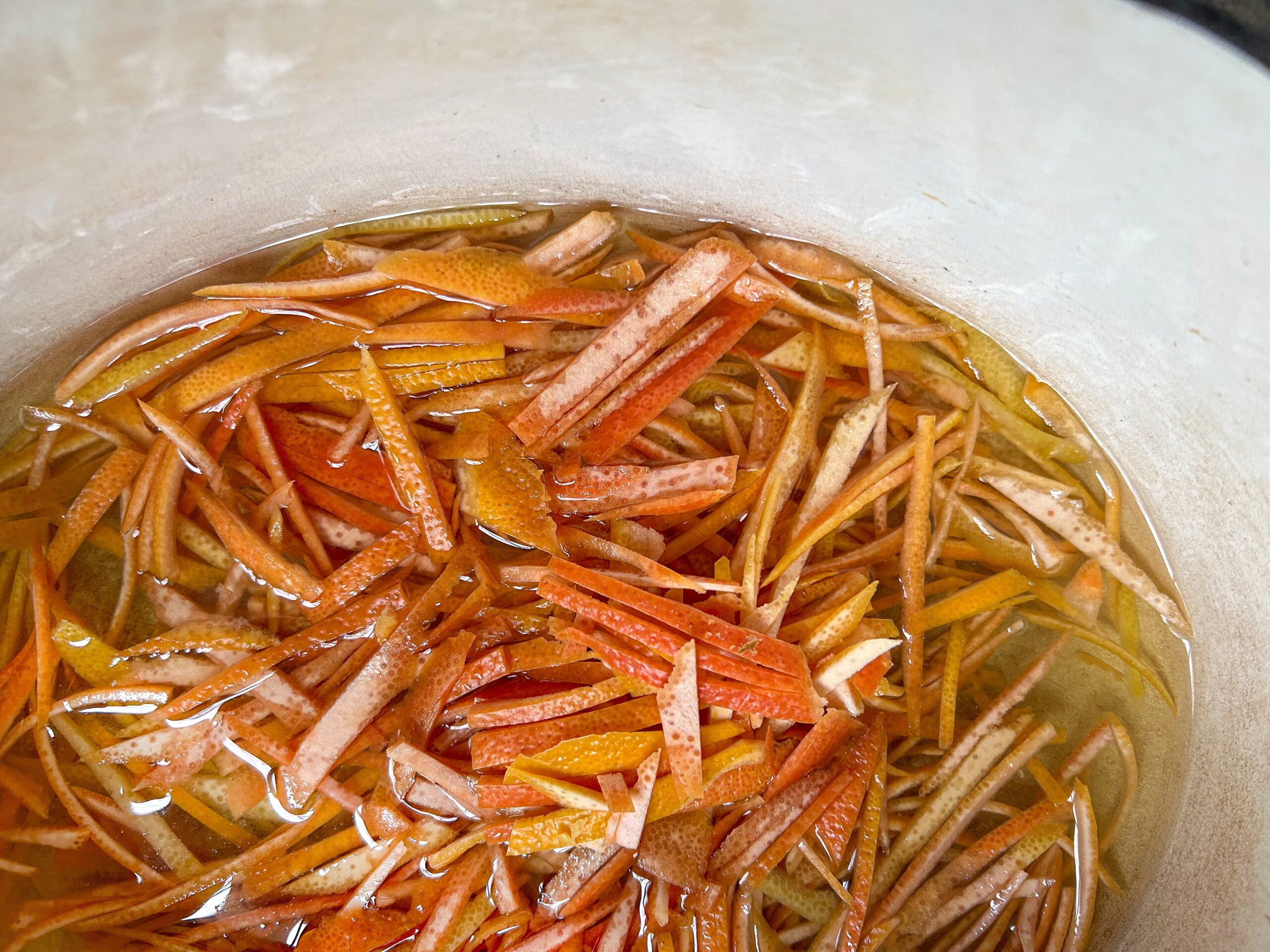
As the mixture simmers, cut a small piece from each end of the grapefruit using a sharp knife.
This next step should be done over a shallow bowl, allowing you to retain as much juice as possible from the grapefruit.
Working in strips from top to bottom, remove the remaining white peel (pith) from the grapefruit, and discard.

Once you have removed as much of the outer peeling as possible, you must cut through the membranes of the grapefruit slices, gently remove the fleshy segments from within, and discard the thin membranes.
It may be easier to portion the grapefruit into slices before cutting the membranes open.
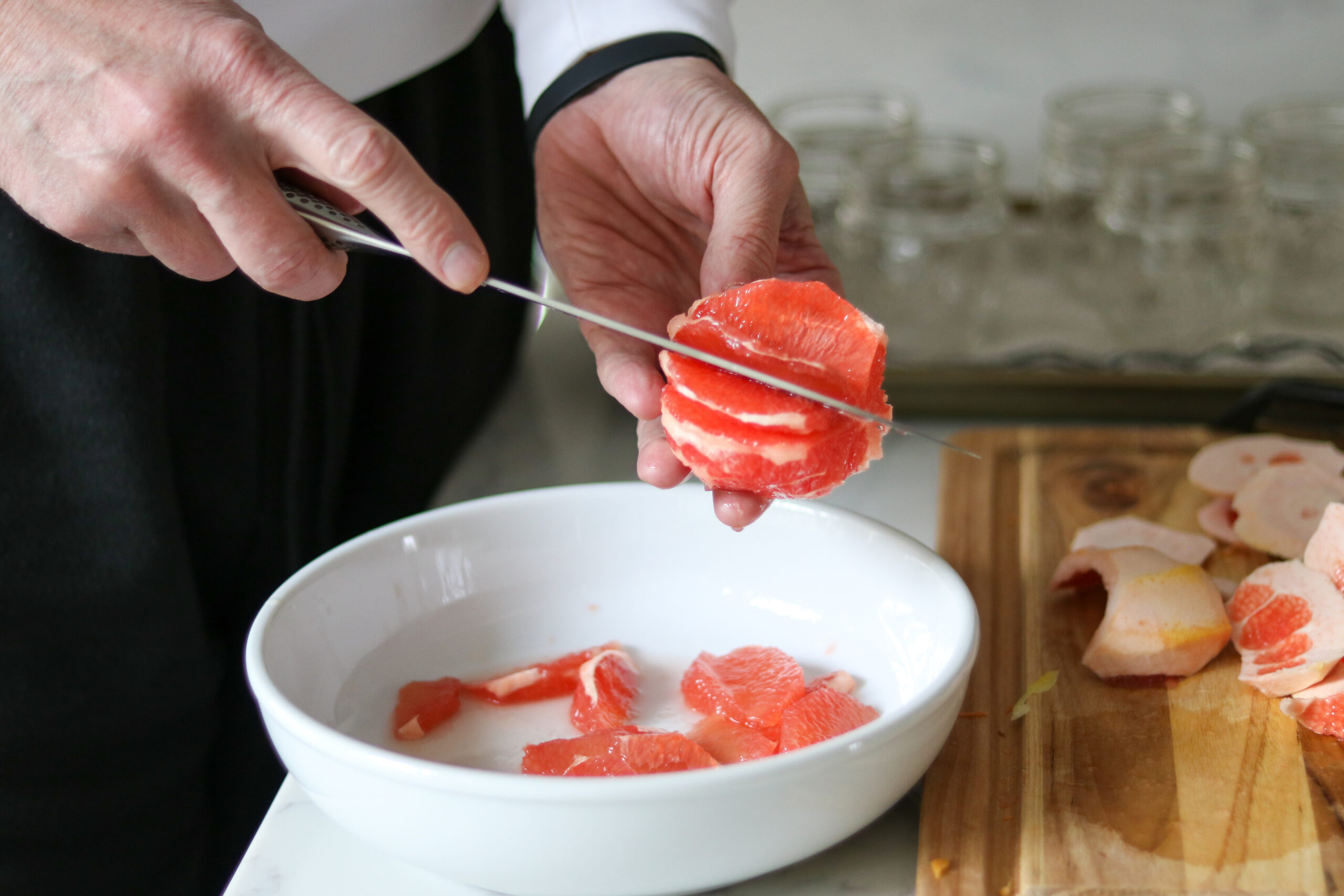
Red grapefruit also tends to have many seeds, some of them very small. Remove as many seeds from the fruit as possible while you remove the membranes. The seeds will not soften as the rinds will, so you don’t want them in your marmalade.
Once you have removed the white peeling, membranes, and seeds from the grapefruits, do the same with the lemon.
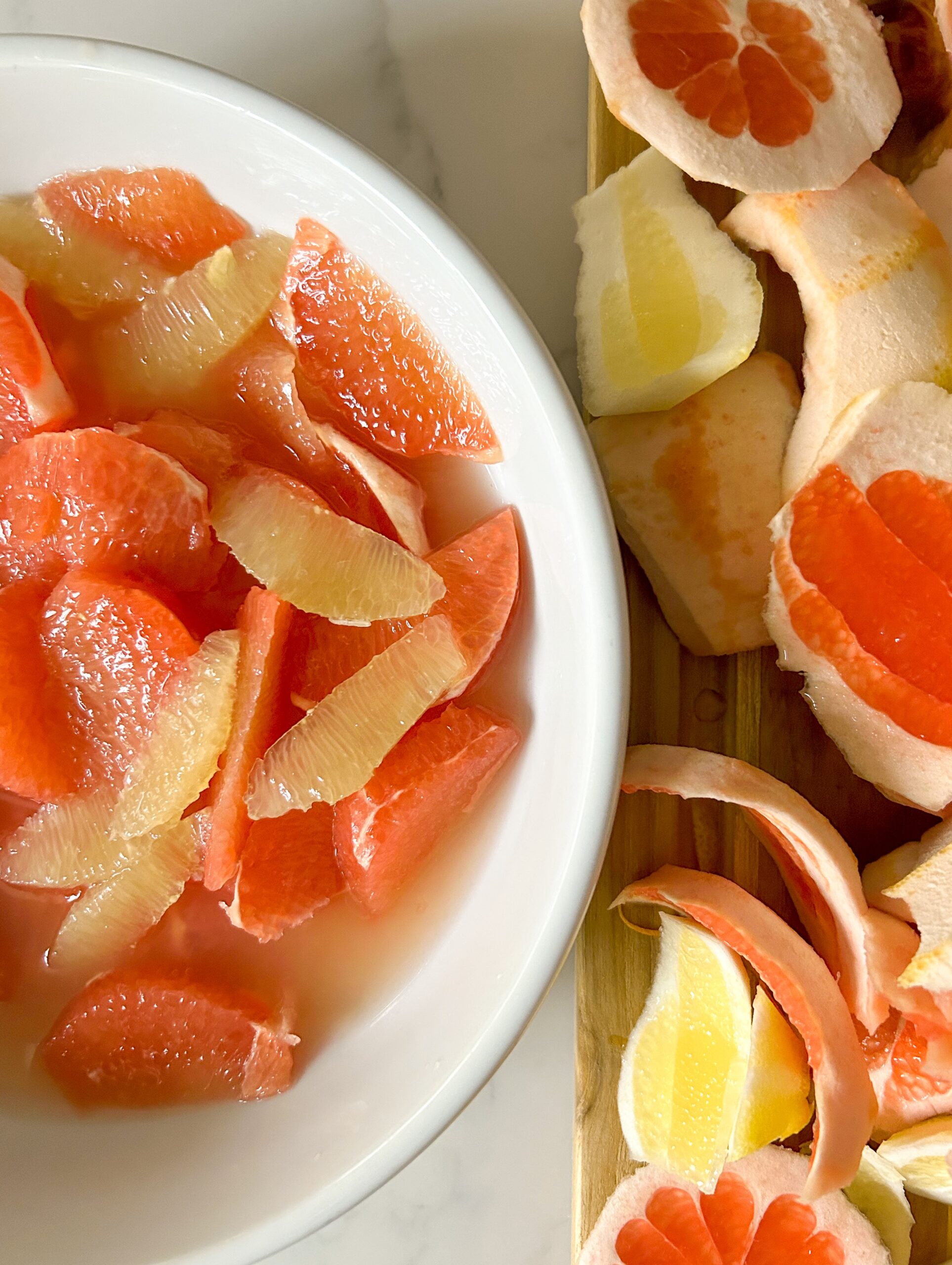
Lemon membranes are less likely to be as tough as grapefruit membranes, so if desired, you may chop the lemon with the membranes intact, but carefully remove any seeds first.
Coarsely chop the grapefruit and lemon, still retaining the juices. You want to have 2¼ cups of fruit and juice.
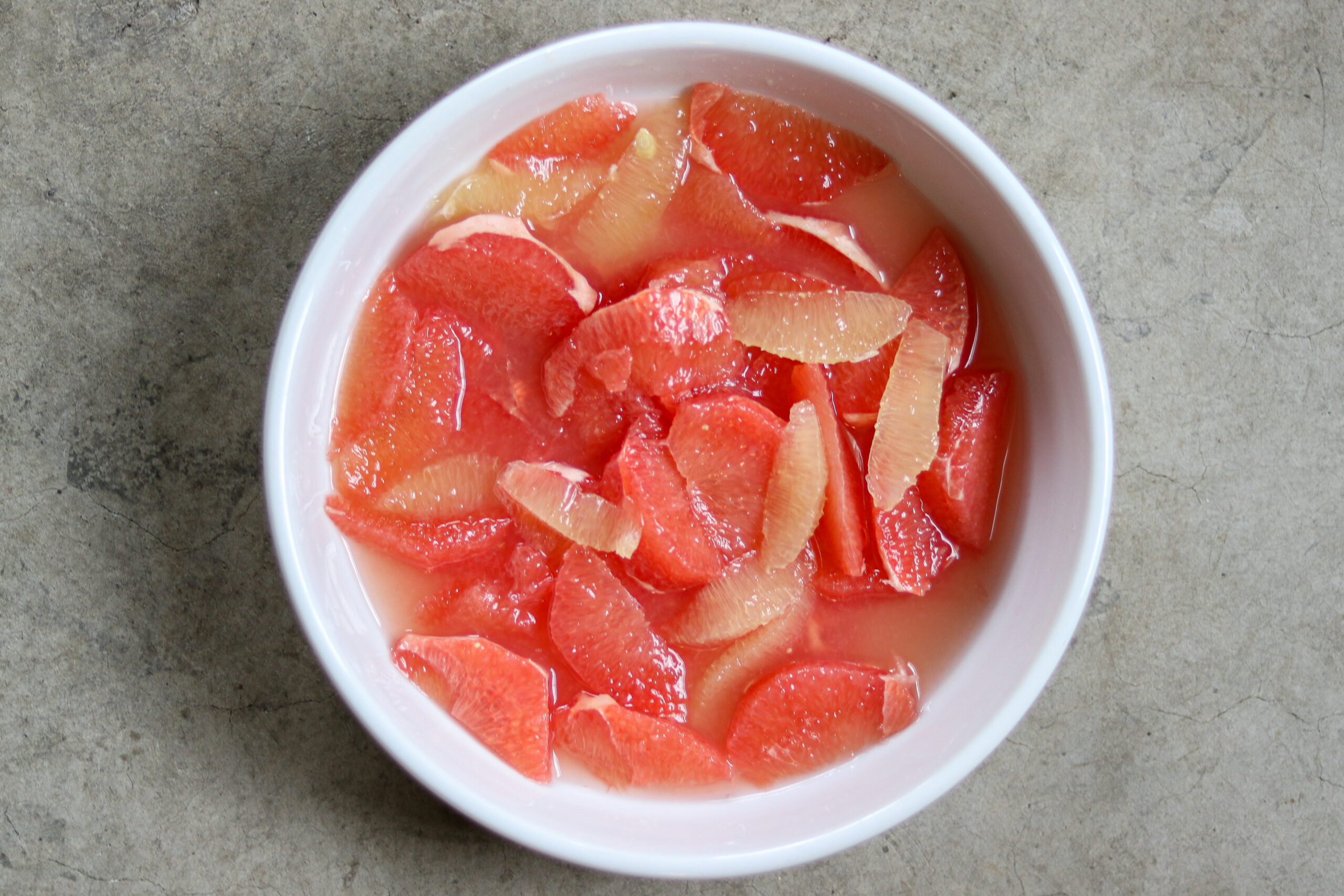
Add the fruit and juice to the saucepan with the peelings after they have simmered for at least 20 minutes.
Increase the heat back to medium-high and bring the mixture to a boil, stirring often.
Once boiling, reduce the heat, simmer uncovered for 10 minutes, and stir occasionally.
After 10 minutes, increase the heat once more and return the mixture to a full boil.

Add the package of pectin to the mixture, stirring constantly to dissolve the pectin, and maintain a full rolling boil, meaning the bubbles do not stop as you continue to stir.
Slowly add the 4 cups of sugar, stirring constantly to dissolve the sugar and prevent scorching.
Again, bring the mixture back to a full rolling boil, and boil hard for exactly one minute.
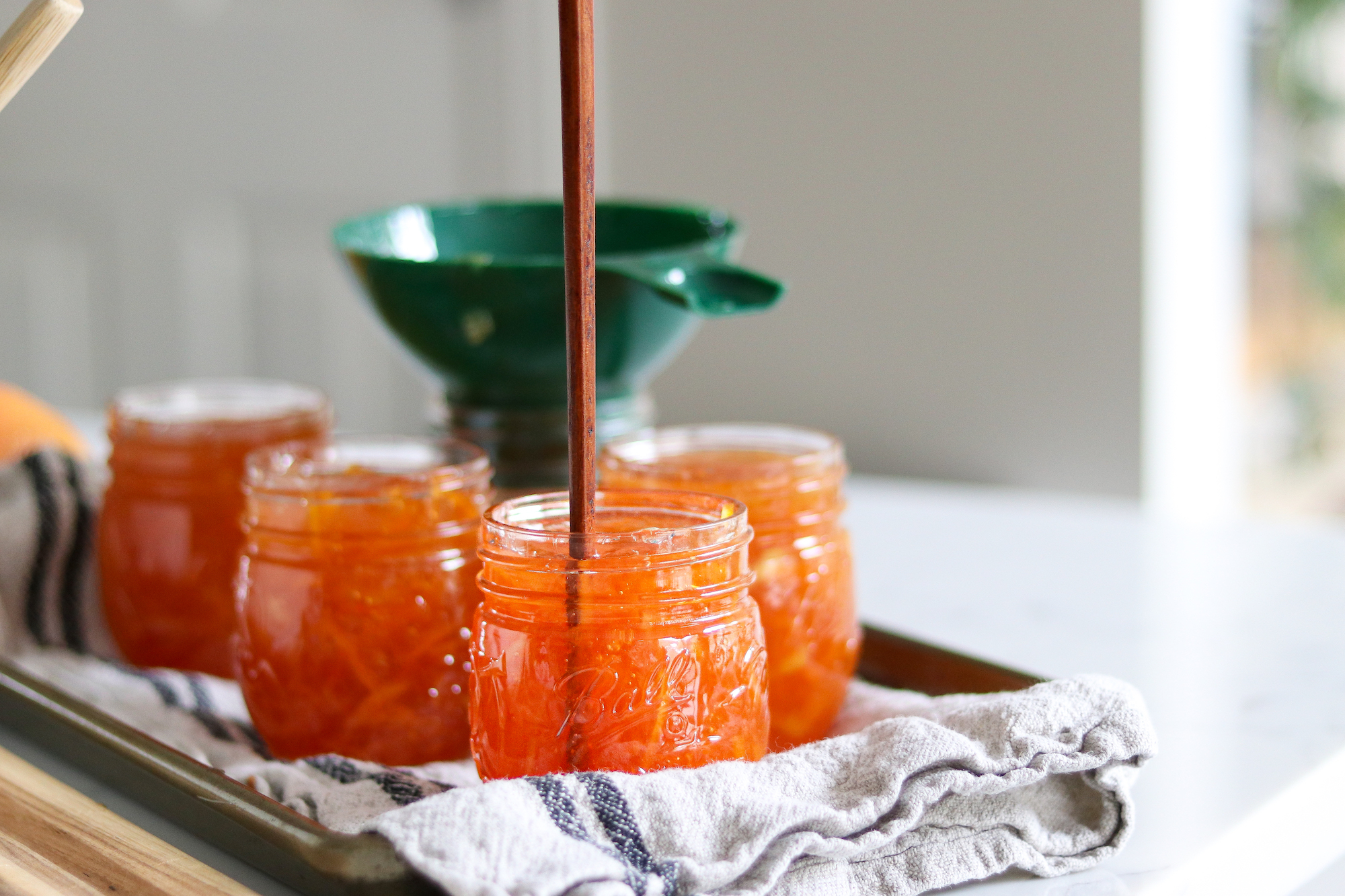
Remove the marmalade from heat, and skim off any foam with a metal spoon.
Immediately pour or ladle the marmalade into prepared jelly jars or containers, leaving ¼” headspace at the top.
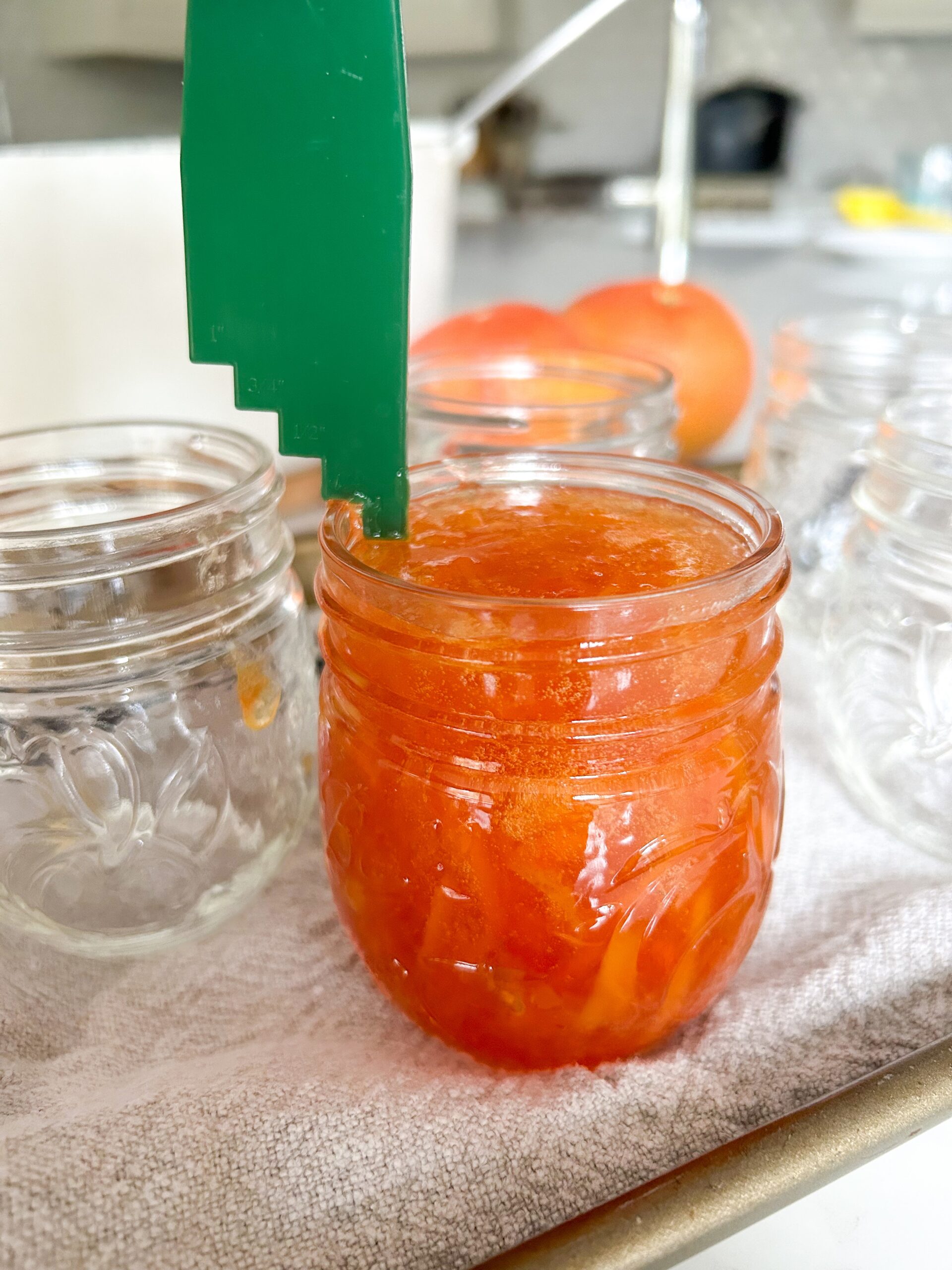
Wipe the rims of the jars or containers using a clean, damp cloth.
If you plan to refrigerate or freeze your marmalade, use freezer-safe containers and airtight lids. Place lids on the containers and allow them to cool on the counter before refrigerating or freezing.
Personally, I prefer canning because it allows me to enjoy this preserve year round right from my pantry shelf.
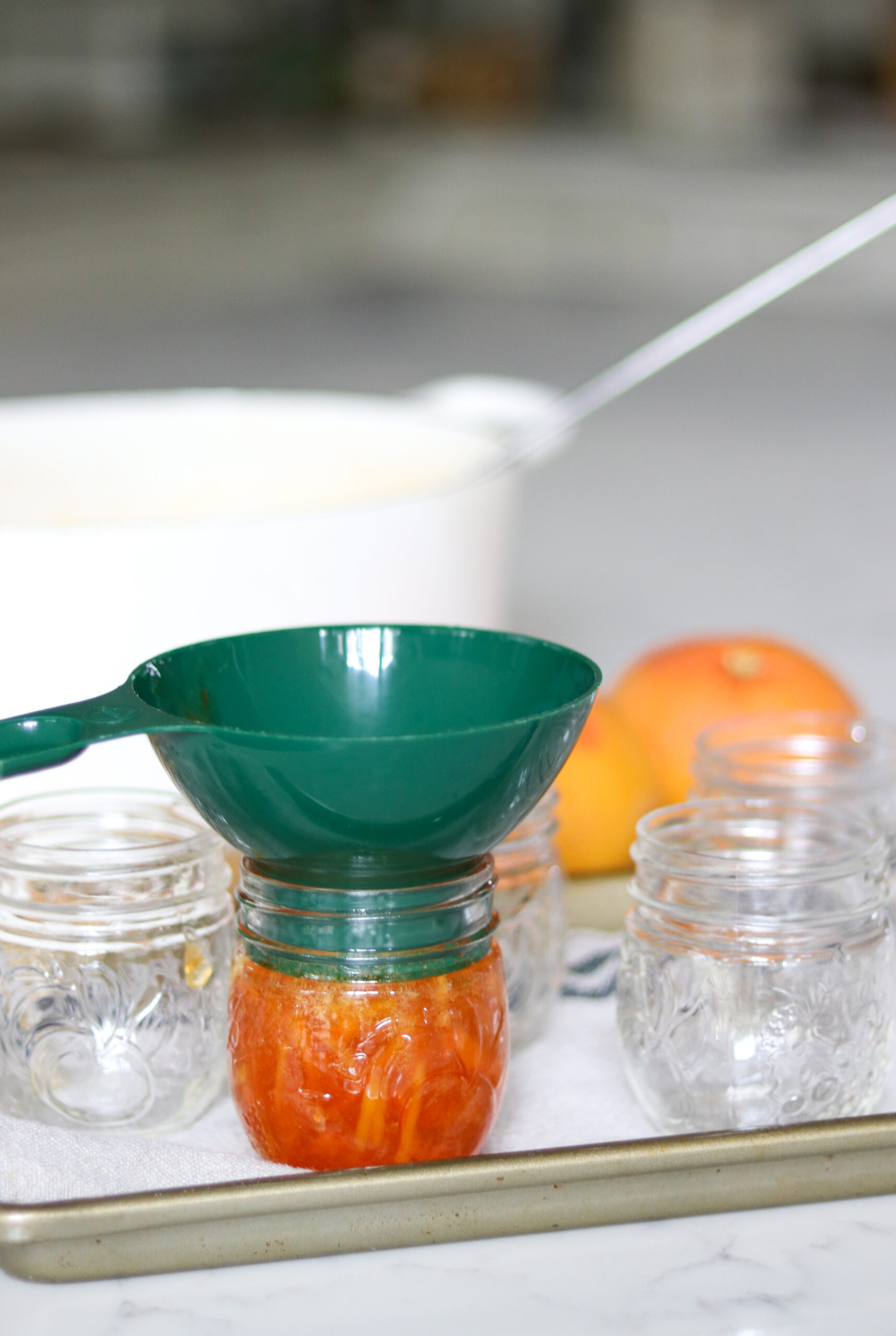
Marmalade should set up as it cools and will maintain freshness in your freezer for up to 6 months. Use refrigerated marmalade within 3 weeks.
For canning your marmalade, use 2-part canning lids and mason jars intended for canning. Place the 2-part canning lids on the jars and tighten them by hand. Do not use a tool or try to screw the lid on too tightly.

Canning Grapefruit Marmalade
Load the jars into your preheated canner and bring the water to a boil. Once boiling, start the timer and process the jars for 10 minutes or the time required for elevation. Refer to the chart included with the pectin for processing time adjustments.
After the processing time is complete, turn off the heat and allow the jars to sit in the water bath for 5 minutes. This extra time is optional, but allows the jars to cool slightly and can help prevent siphoning.
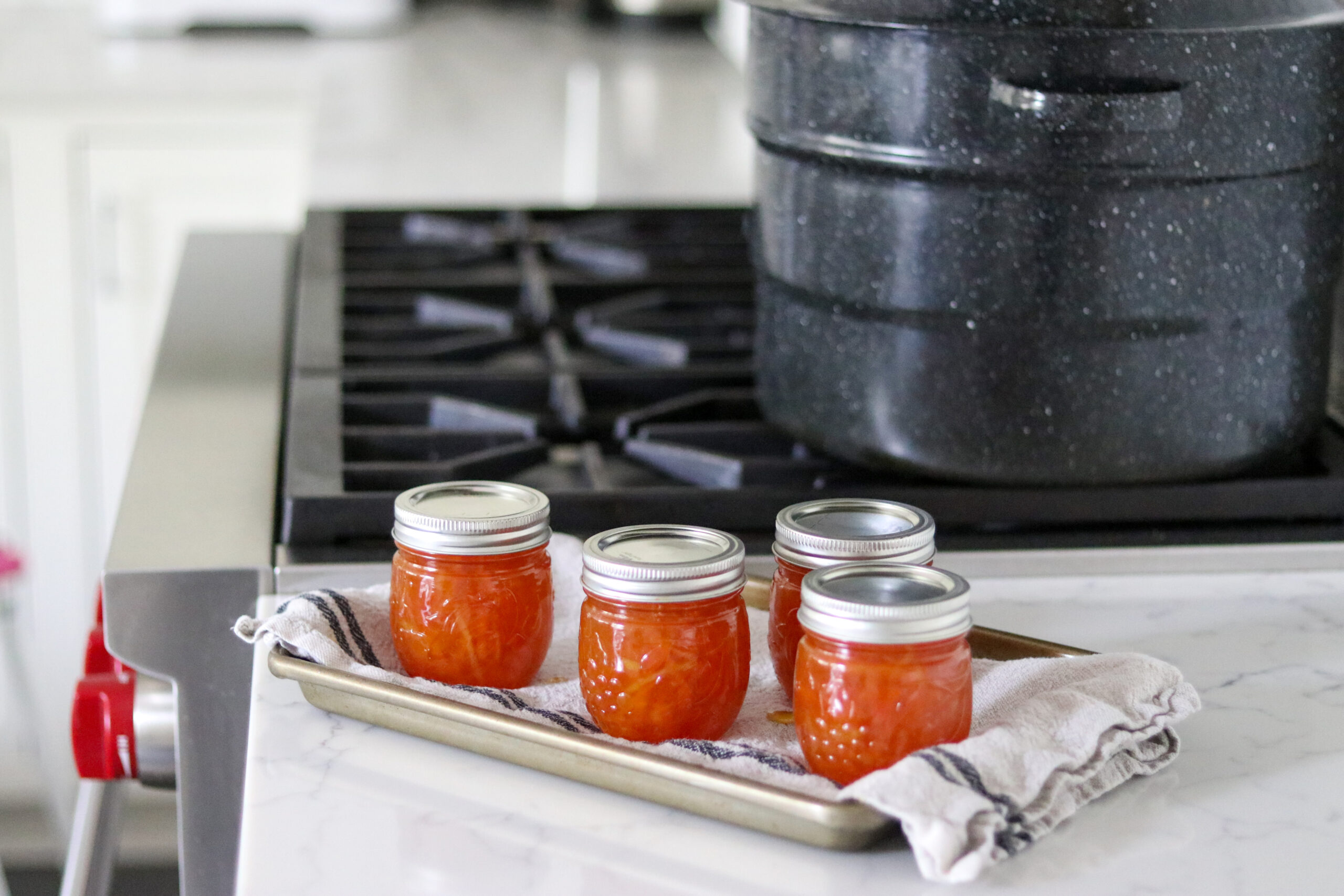
Use a jar lifter to remove the jars from the canner and set them to cool on a towel on the counter.
After 24 hours, check the jars to see if the lids have sealed. If there is a “bubble” in the center of the lid, continue to let it set or store it in the refrigerator for immediate use. If the jar does not seal after 48 hours, refrigerate the jam and use it within three weeks.
The grapefruit marmalade will maintain quality in your pantry or a cool, dry place for up to 12 months or even longer if the jars remain sealed. Refrigerate after opening, and use within three weeks.
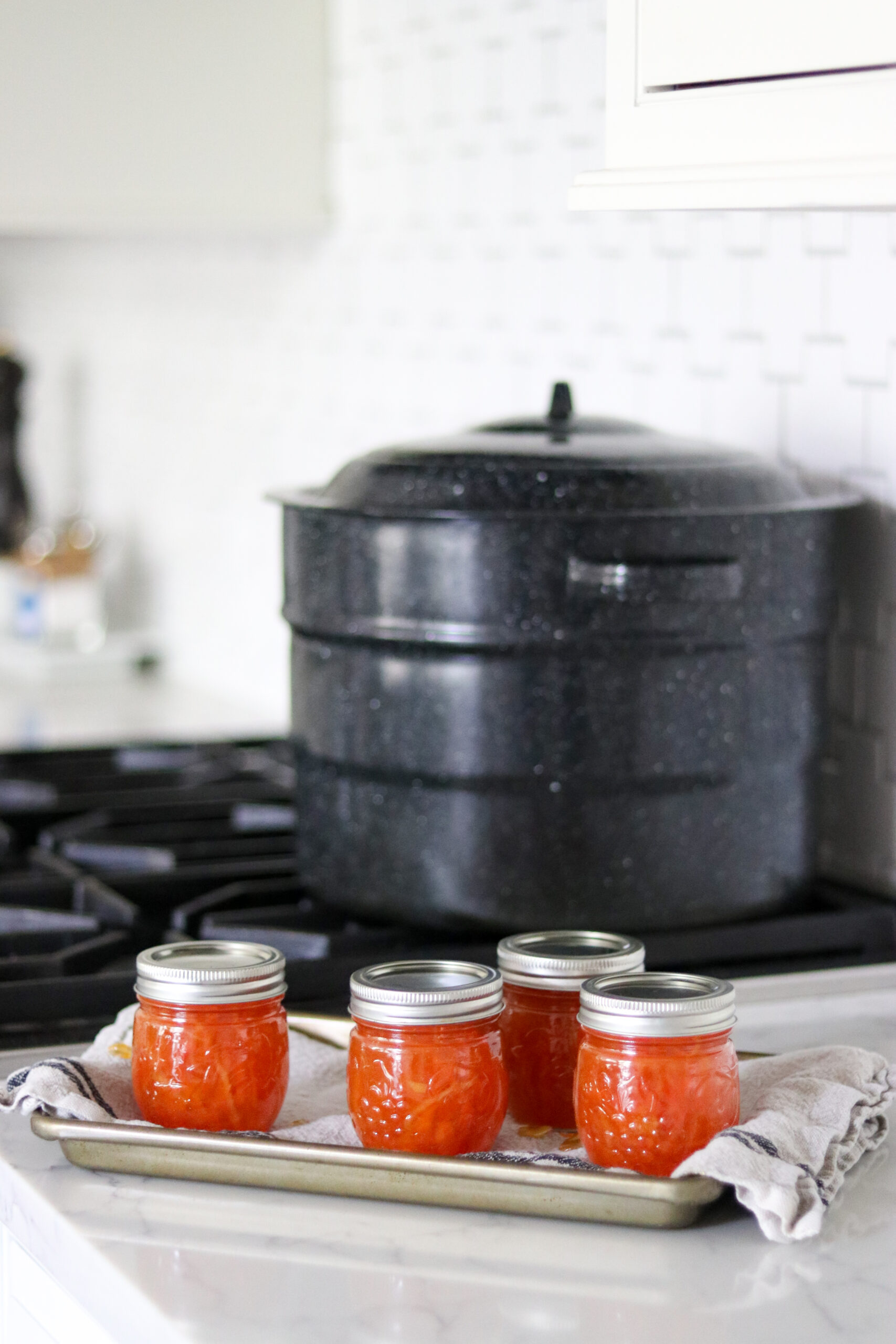
Altitude Adjustments for Marmalade
Water boils at a lower temperature at higher altitudes, so the canning time needs to be increased at very high altitudes.
- For 0 to 3,000 feet in elevation – Process half pint jars for 10 minutes
- For 3,001 to 6,000 feet in elevation – Process half pint jars for 15 minutes
- Above 6,001 feet in elevation – Process half pint jars for 20 minutes

Grapefruit Marmalade Jam Variations
Grapefruit has its own tangy citrus flavor that is both slightly sour and slightly sweet at the same time.
If you prefer something sweeter, try substituting some grapefruit with sweet oranges or mandarin oranges.
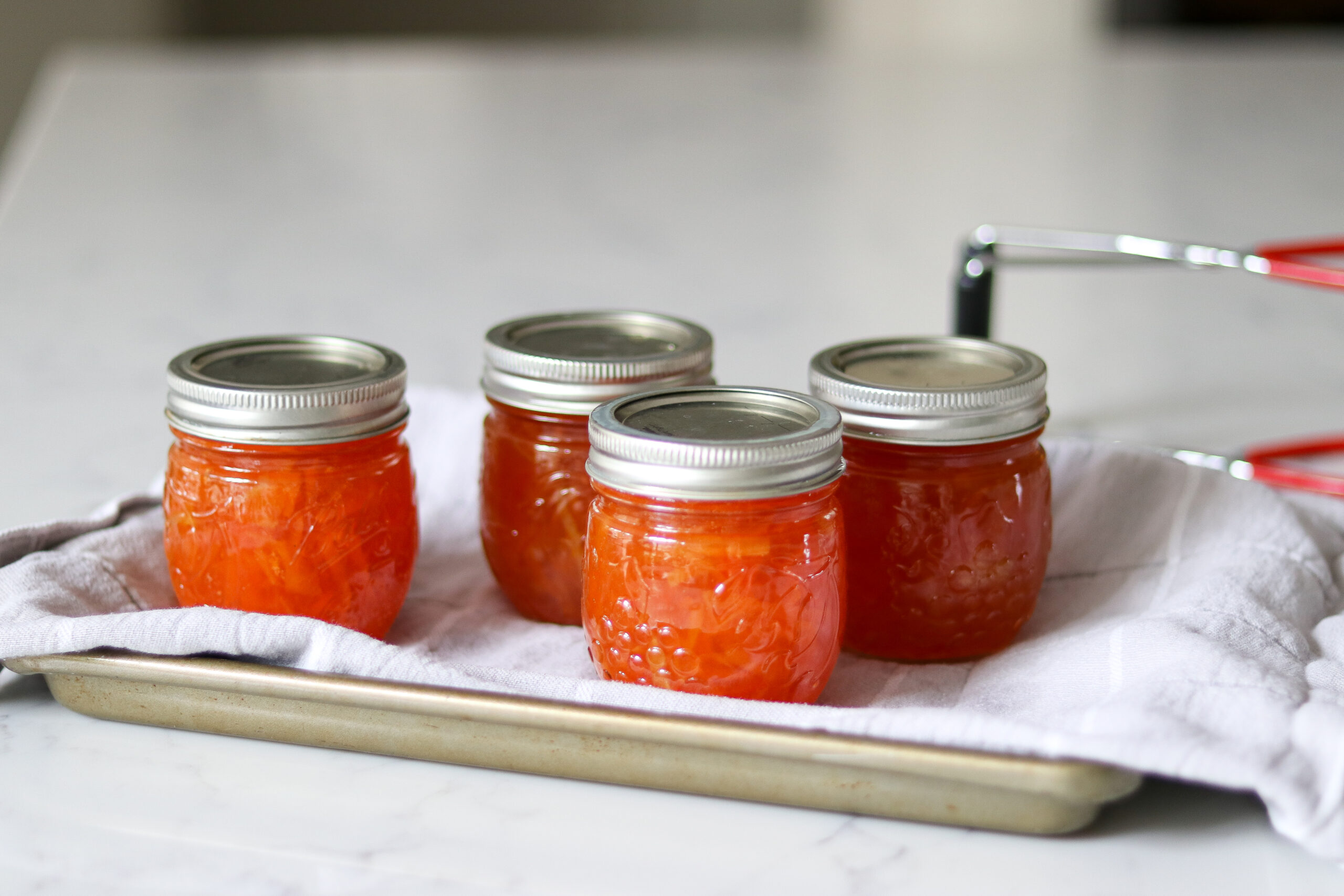
If you have access to bergamots, their flavor also blends well with grapefruit. Again, substitute some bergamot flesh with the grapefruit, and also use some of the rind for the very distinct aroma and flavor of bergamot.
Vanilla is another flavor that can help “mellow” the tang of grapefruit. Add one or two crushed vanilla beans to the rind mixture, or add ½ teaspoon vanilla extract to the marmalade mixture as it cooks.
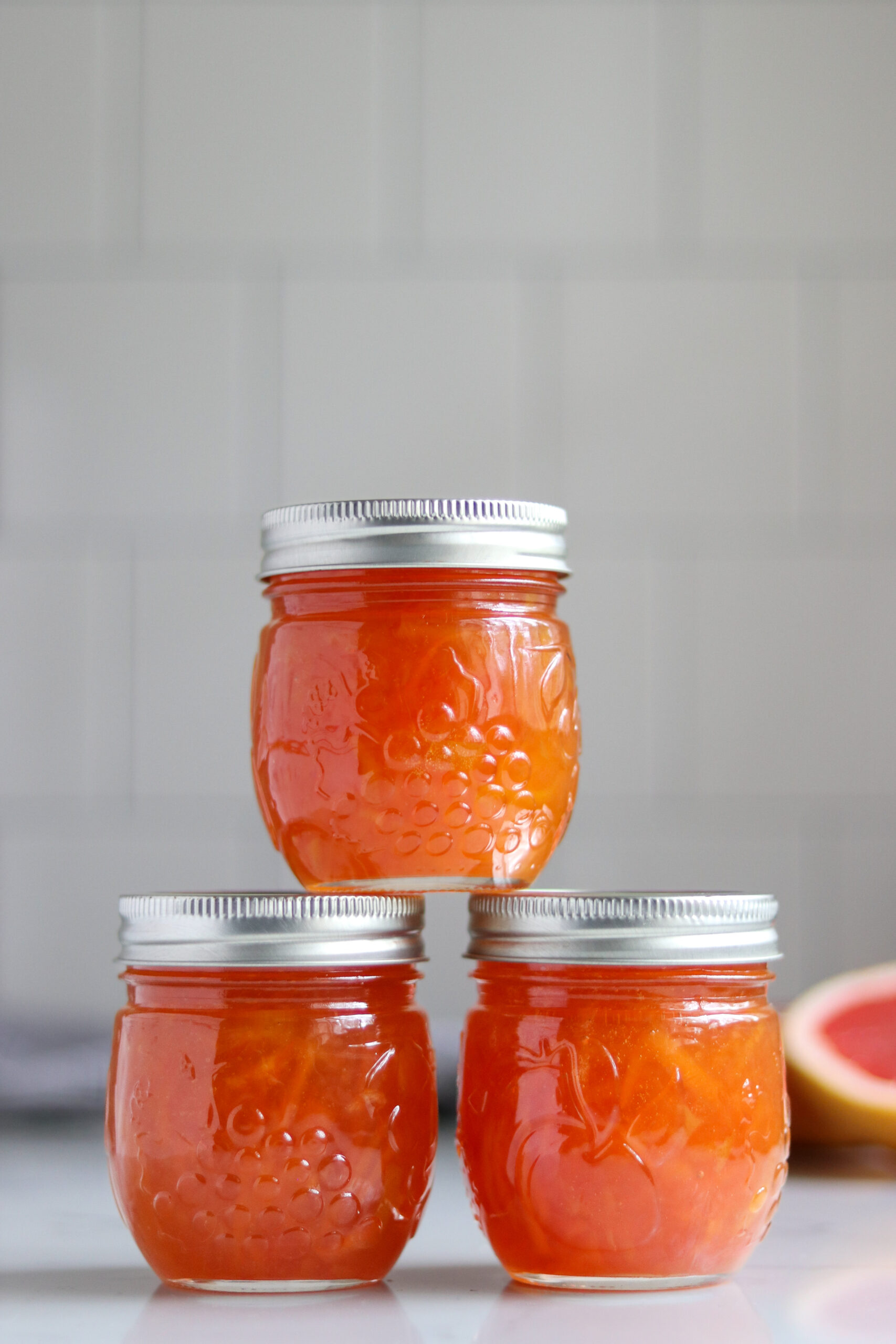
Ways to Use Grapefruit Marmalade Jam
Grapefruit marmalade brings a lovely zing of flavor to your breakfast toast, croissant, or English muffin.
Add grapefruit marmalade to your yogurt and granola for a great citrus flavor, or use it as a topping for vanilla ice cream.
Citrus marmalades such as grapefruit make exceptional glazes for grilled pork chops, fish, or chicken.
Try using grapefruit marmalade as a dipping sauce for coconut shrimp or chicken fingers.
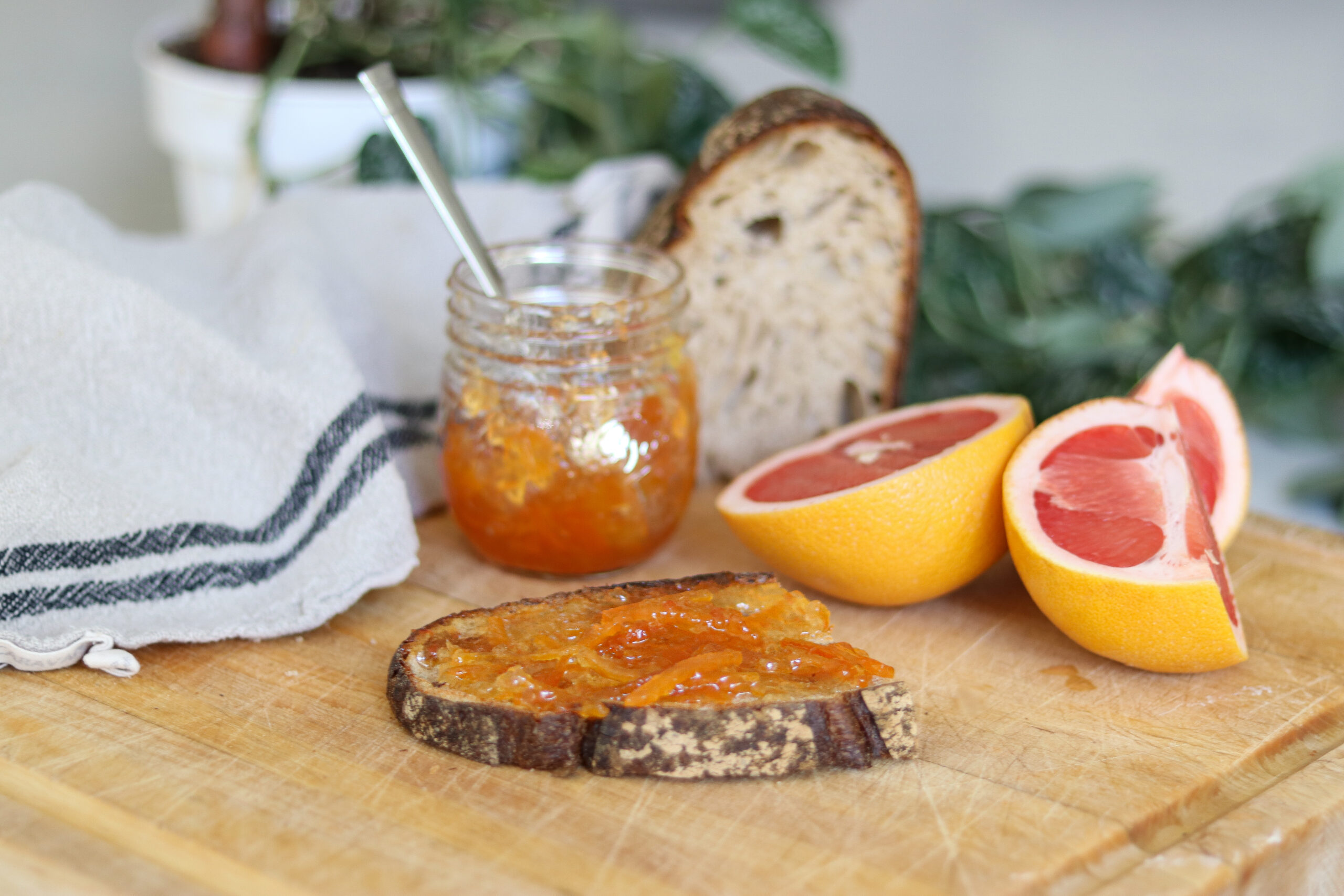
Ways to Preserve Citrus
Looking for more ways to preserve citrus?
I have a list with dozens of ways to preserve lemons, and most of those methods work wonderfully with grapefruit. If you’re looking for a simple method, canning grapefruit sections is one of the easiest ways to put up a bumper crop of grapefruit in season.
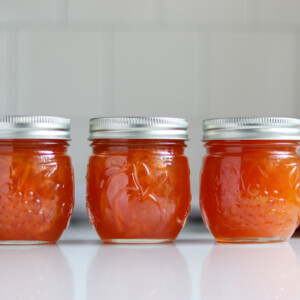
Grapefruit Marmalade
Ingredients
- 3 large red grapefruits
- 1 medium lemon
- 4 cups granulated sugar
- 2½ cups water
- 1/8 tsp. baking soda
- 1 box powdered pectin, 1.75 oz. Sure-Jell regular pectin (or 6 Tbsp. Ball Classic Pectin)
Instructions
- Wash the grapefruits and lemons with a vegetable brush. Optionally, you may use 2 tablespoons of baking soda mixed with 1 cup of water to wash your fruit.
- Remove the outer colored part of the grapefruit with a vegetable peeler. Cut only the outer layer, and do not get too much of the bitter white inner peeling (pith). Do the same with the lemon.
- Chop the grapefruit and lemon peels coarsely and place in a large saucepan.
- Add 1/8 tsp. baking soda and 2 ½ cups of water, stir to mix.
- Bring the grapefruit and lemon peel mixture to a boil, cover, and reduce the heat to medium-low.
- Simmer the mixture for 20 minutes, stirring occasionally.
- Cut off a small piece on each end of the grapefruit and lemon using a sharp knife.
- Working over a shallow bowl, remove the remaining white peeling from the fruit in strips from top to bottom until you have removed as much of the white layer as possible.
- Slice open the membranes surrounding each grapefruit segment and carefully pull out the fleshy part of the fruit. Remove all seeds, and discard the membranes and seeds. Retain as much of the juice as possible in the shallow bowl.
- Remove the membranes from the lemon segments in the same manner, or leave the membranes and chop the lemon into small pieces.
- Chop the grapefruit into small pieces.
- Add the grapefruit, lemon, and all juices to the peeling mixture, increase the heat, and stir often until the mixture comes to a boil.
- Reduce the heat to medium-low and simmer, uncovered, for 10 minutes.
- Increase the heat to high and bring the fruit mixture back to a hard boil, stirring often.
- Add the package of pectin to the boiling fruit mixture, stirring to dissolve, and heat to a full rolling boil that does not stop as you are stirring.
- Slowly add the sugar, stirring continuously, until all the sugar has been added and the jam returns to a full rolling boil.
- Boil the jam for exactly one full minute.
- Remove the marmalade from the stove and, optionally, skim the foam off the marmalade with a metal spoon.
- Immediately pour or ladle the hot marmalade into prepared jars or freezer-safe containers, leaving ¼" headspace at the top of the jars.
- Wipe the rims of the jars or containers with a clean cloth, and apply the lids.
- Allow the marmalade to cool on the counter before freezing or refrigerating. If canning, preserve the marmalade using a hot water bath canning method for 10 minutes (or adjust processing time for altitude according to the chart).
- After the processing time has elapsed, turn off the heat and leave the jars in the water bath for 5 more minutes (optional, but recommended).
- Using a jar lifter, remove the marmalade and place the jars on a towel on the counter to cool for 24 hours. Check the seals and refrigerate any unsealed jars.
- Sealed marmalade will retain peak quality for up to 12 months stored in a cool, dry place or pantry. If you did not can your marmalade, it could be stored in the freezer for up to 6 months or refrigerator for 3 weeks. Refrigerate the marmalade once opened.
Notes
Altitude Adjustments for Marmalade
Water boils at a lower temperature at higher altitudes, so the canning time needs to be increased at very high altitudes.- For 0 to 3,000 feet in elevation – Process half pint jars for 10 minutes
- For 3,001 to 6,000 feet in elevation – Process half pint jars for 15 minutes
- Above 6,001 feet in elevation – Process half pint jars for 20 minutes
Low Sugar Variation
*You will get a lower yield using less sugar and low sugar pectin. Low-sugar pectin can be used to make marmalade, which calls for less sugar than the regular pectin recipe. The amount of sugar is typically about half that of the traditional pectin recipe. Sure-Jell Premium Fruit Pectin for Less or No Sugar Needed Recipes is a reliable brand for making jelly with less sugar. I have consistently used this low-sugar pectin obtaining excellent results. Another option is Pomona's Universal Pectin for low-sugar recipes. You will need to follow the instructions in the box, as this pectin is a 2-part low-sugar pectin, and the steps are different than regular pectin.Nutrition
Nutrition information is automatically calculated, so should only be used as an approximation.
Marmalade Recipes
You can make marmalade with just about any citrus fruit!
Citrus Canning Recipes
Looking for more ways to put citrus fruit in a jar?
- Canning Lemon Curd
- Canning Lemonade (and Lemonade Concentrate)
- Canning Strawberry Lemonade Concentrate
- Canning Limeade (& Limeade Concentrate)
Marmalade Recipes
Once you’ve mastered this recipe, why not try other citrus varieties?
Orange Marmalade is a classic choice, while Blood Orange Marmalade offers a stunning visual and flavor experience.
For a lower sugar option, our Low Sugar Orange Marmalade (with pectin) is a great alternative. If you’re feeling adventurous, give Buddha’s Hand Marmalade a try for its unique fragrance and flavor. Remember, our Marmalade with Any Citrus recipe allows for endless experimentation with different citrus combinations!
